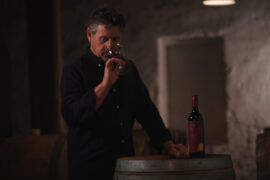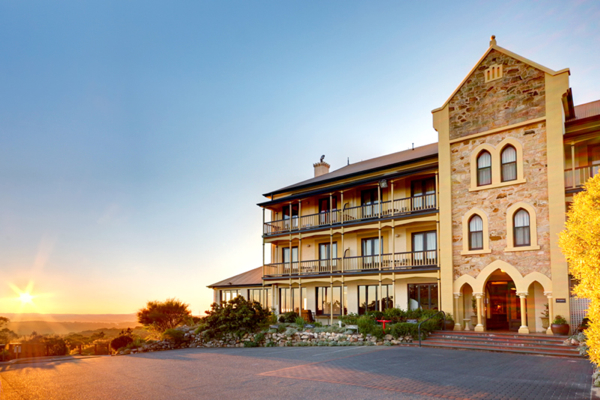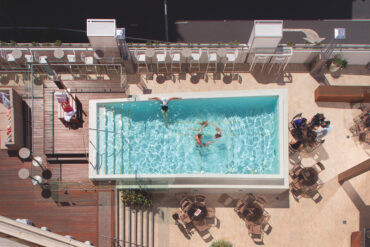Published in The Canberra Times Food & Wine section, 14 May, 2003.
The National Riesling Challenge, held earlier this year, put Barossa producer, St Hallett, on the map inCanberra, but recognition at home for its Eden Valley Riesling had already come in the form of a win at last year’s Barossa Wine Show.
And now chief winemaker, Stuart Blackwell, has added to the accolades by being named 2003 Barossa winemaker of the year.
The award was presented at a declaration of vintage ceremony held as part of the Barossa Vintage Festival, which recently wrapped up a week of frolicking, from dinners and concerts in the wineries to a festival parade, winery tours and the popular Yalumba harvest market and cooking school.
The 2002 St Hallett Riesling, with its citrus notes and crisp natural acidity, epitomises the style of wine being produced in theEdenValley, adjoining the Barossa. The 2001 vintage of the same wine was served at Legends of the Long Lunch, one of the most popular events on the Vintage Festival calendar. This year’s lunch featured two Australian wine writers, Phillip White and Tim White, and one New Zealand writer, Paul White, who spoke eloquently about their passion for wine over a lunch of roast duck with star anise tamarind glaze.
The dish was matched with St Hallett’s 2000 Blackwell Shiraz, a big, bold wine just like the man behind the label, Bob McLean, who used the occasion to hand over the reins to winemaker Blackwell. The grapes for the Blackwell Shiraz come from non-irrigated bush vines that are between 70 and 100 years old, producing tiny yields of highly concentrated fruit and resulting in a wine with chocolate and soft, ripe berry characters. It’s a style unique to the Barossa and a wonderful legacy for Australian wine in general.
Since arriving at St Hallett in 1984, Stuart Blackwell has established the winery’sshirazas quintessential Barossa, not only with its flagship Old Block Shiraz but also with Blackwell and another Shiraz called Faith. In a region with more than its fair share of outstanding winemakers, Blackwell’s award as Barossa winemaker of the year is no mean feat, especially because the winner is nominated by his or her own peers.
During the festival, St Hallett’s 2002 Riesling was offered for tasting alongside Peter Lehmann’s 1997 Reserve Riesling, also from theEdenValleyand another winner at the National Riesling Challenge in Canberra, where it took out the museum class. Together, the two wines show how the valley can produce riesling that not only drinks beautifully while young but also develops into complex, rich wines with age.
Peter Lemann’s chief winemaker, Andrew Wigan, says of the 1997 Reserve,
‘We’ve been selecting the finest parcel of the vintage since 1987 and held it back from release for five years so we can get those wonderful lime characters and honeyed overtones, yet it still finishes dry with the austerity and breeding that Eden Valley is known for.’
Peter Lehmann Wines also recently released a 1998 Reserve Semillon ($24), so that consumers can appreciate the richer, fuller-flavoured characters of bottle-aged wine. In contrast with the zestry citrus fruit characters of young Barossa Semillon, it has delicious layers of honeyed fruit.
In the mid 1990s, winemaker Grant Burge thought Semillon was going to become THE Barossa white. Now he is not so sure, consumer demand for it being cooler than he expected. “In the last four or five years, winemakers have tried to lay off the oak and I think that’s very good for the style,” he said.
Although the Barossa is best known for riesling andshiraz, Burge’s success with Semillon shows it is capable of producing other styles as well. Yalumba Wines, for example, is doing marvellous things with viognier, its 2002 Eden Valley Viognier showing just how far it has come after 20 years of devotion to this rareRhonevariety. The 2002 vintage has a rich, long palate with intense apricot notes and more floral characters than in previous vintages.
Andrew Ewart, chief winemaker at Mountadam, believes the character common to allEdenValleywines is their acidity. He attributes this to the soils, which unlike those in the Barossa proper, are sandy and free-draining: ‘You can put irrigation on here but it tends to go straight through.’
Henschke Wines produces a cabernet fromEdenValleyfruit, its 1999 Cyril Henschke a tribute to its namesake who planted cabernet in theEdenValleyas early as the 1960s.
Perhaps one of the best bargains coming out of theEdenValleyis the 1997 Miranda Shiraz Cabernet ($28). The fruit comes from 50-year-old vines that are virtually dry-grown, and the wine has a generosity and depth although the tannins are fine and soft.
Consumers after a blockbuster red need look no further than the Barossashirazproduced under a range of wonderful labels such as E & E Black Pepper, Saltram No 1, Bethany GR6 Reserve, Centenary Hill, Elderton Command Shiraz, Peter Lehmann Stonewell, Mountadam Patriarch and Grant Burge Meshach.
And then of course there is the icon Henschke Hill of Grace, which has gone beyond all reason to fetch extraordinary prices: $38,000, to be precise, at the Penfolds Barossa Rare Wine Auction held during the festival. The money was paid for an imperial (six-litre) bottle of the 1998 vintage.
The atmosphere in Penfolds’ barrel hall was electric as the 154 lots of rare and sought after wine were auctioned, culminating in the sale of an imperial of 1998 Grange for a world record price of $64,000. It’s a charity auction, with proceeds going to the vintage festival, boding well for the success of the next one in two years time.
Although commonly known as ashiraz, Grange often has a small amount of cabernet sauvignon, the 1998 vintage having around three per cent. It has just come onto the market, at around $395.
Wolf Blass puts more cabernet thanshirazinto its Black Label wine, another classic. The current release 1999 Black Label is the 27th vintage of this much awarded wine, and while the cabernet comes from McLaren Vale, most of the shiraz comes from the Barossa (the blend is 53 per cent/47 per cent).
It sells for $125, but if you want to come down a peg or two, there’s the 2001 Grey Label Cabernet Sauvignon for $40 or the 2001 Brown Label Shiraz for $37.
The enormous Wolf Blass winery was the setting for the Barossa Vintage Festival’s flagship event, Fire, Feast & Ferment. Fire trucks, fire eaters and coopers shaping oak barrels over open flames, greeted festival goers who were served a feast of platters at long tables set up in the barrel hall.
Barossa chefs drew on their superb regional produce, including Barossa chook and Linke’s lachschinken (a ham-like salmon), with guests helping themselves in the spirit of sharing that the festival has come to represent.
© Christine Salins




